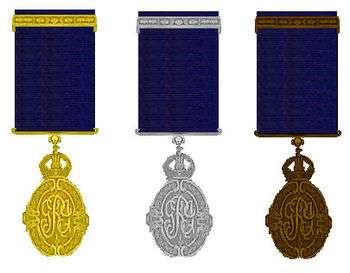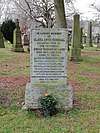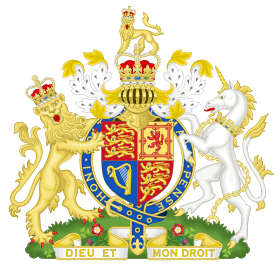Kaisar-i-Hind Medal
The Kaisar-i-Hind Medal for Public Service in India was a medal awarded by the Emperor/Empress of India between 1900 and 1947, to "any person without distinction of race, occupation, position, or sex ... who shall have distinguished himself (or herself) by important and useful service in the advancement of the public interest in India."[1]
| Kaisar-i-Hind Medal | |
|---|---|
 Representations of the Gold, Silver and Bronze Medals. George V, second type | |
| Awarded by Emperor of India | |
| Country | British Empire |
| Type | civil decoration |
| Eligibility | civilians of any nationality |
| Awarded for | distinguished service in the advancement of the interests of the British Raj |
| Campaign(s) | dormant since 1947 |
| Statistics | |
| Established | 10 April 1900 |
| Precedence | |
| Next (higher) | Order of British India |
| Next (lower) | Order of St John |
Ribbon of Kaisar-i-Hind Medal | |
The name "Kaisar-i-Hind" (Urdu: قیصرِ ہند qaisar-e-hind, Hindi: कैसर-इ-हिन्द) literally means "Emperor of India" in the Hindustani language. The word kaisar, meaning "emperor" is a derivative of the Roman imperial title Caesar, via Persian (see Qaysar-i Rum) from Greek Καίσαρ Kaísar, and is cognate with the German title Kaiser, which was borrowed from Latin at an earlier date.[2] Based upon this, the title Kaisar-i-Hind was coined in 1876 by the orientalist G.W. Leitner as the official imperial title for the British monarch in India.[3] The last ruler to bear it was George VI.[4]
Kaisar-i-Hind was also inscribed on the obverse side of the India General Service Medal (1909), as well as on the Indian Meritorious Service Medal.[5]
History
Empress of India or Kaisar-i-Hind, a term coined by the orientalist G.W. Leitner in a deliberate attempt to dissociate British imperial rule from that of preceding dynasties[3] was taken by Queen Victoria from 1 May 1876, and proclaimed at the Delhi Durbar of 1877.
The medal was instituted by Queen Victoria on 10 April 1900.[6] The name translates as "Emperor of India" (a name also used for a rare Indian butterfly, Teinopalpus imperialis). The Royal Warrant for the Kaisar-i-Hind was amended in 1901, 1912, 1933 and 1939. While never officially rescinded, the Kaisar-i-Hind ceased to be awarded following the passage of the Indian Independence Act 1947.[7] The awards of the gold medal were often published in the London Gazette, while other classes were published in the Gazette of India.
Medal grades and design
The medal had three grades. The Kaisar-i-Hind Gold Medal for Public Service in India was awarded directly by the monarch on the recommendation of the Secretary of State for India. Silver and Bronze medals were awarded by the Viceroy. The medal consisted of an oval-shaped badge or decoration in gold, silver or bronze with the Royal Cipher and Monarchy on one side, and the words "Kaisar-i-Hind for Public Service in India" on the other. It was to be worn suspended from the left breast by a dark blue ribbon. The medal has no post-nominal initials.[7]
Its most famous recipient is Mohandas Gandhi, who was awarded the Kaisar-i-Hind in 1915 by The Lord Hardinge of Penshurst for his contribution to ambulance services in South Africa. Gandhi returned the medal in 1920 as part of the national campaign protesting the Jallianwala Bagh massacre and in support of the Khilafat Movement.[8][9][10]
Notable recipients
Gold medal
- Sardar Khan Bahadur Mir Abdul Ali, JP, Bombay, 9 November 1901[11]
- Dr Margaret Ida Balfour, Scottish doctor and campaigner for women’s medical health issues[12]
- Dr Mary Ronald Bisset, Scottish physician and missionary for women's medical health.[13][14]
- Richard Burn, for famine services in 1907–08[15]
- Shankar Madhav Chitnavis, Esq., Deputy-Commissioner, Central Provinces, 9 November 1901[11]
- Major General Thomas Arthur Cooke, for distinguished service in the advancement of the interests of the British Raj[16]
- The Lady Curzon of Kedleston, for distinguished service in the advancement of the interests of the British Raj[16]
- Major Herbert Edward Deane, R.A.M.C., 9 November 1901[11]
- Major Thomas Edward Dyson, MB, CM, Indian Medical Service, 9 November 1901[11]
- Mrs E J Firth, of Madras, awarded medal on 9 November 1901 for distinguished service in the advancement of the interests of the British Raj[11]
- Mohandas Karamchand Gandhi (returned 1920)
- Major General Sir William Forbes Gatacre, chairman of the plague committee of Bombay City 1896 and 1897[17]
- N S Glazebrook, Esq., JP, of Bombay, 9 November 1901[11]
- Very Rev John A. Graham, D.D., for distinguished service in the advancement of the interests of the British Raj[16]
- Thomas Holderness, for distinguished service in the advancement of the interests of the British Raj[16]
- Sydney Hutton Cooper Hutchinson, Esq., AMICE, Superintendent of Telegraphs, 9 November 1901[11]
- The Rt Hon. Alice Isaacs, Marchioness of Reading[18]
- Reverend William Henry Jackson of the Blind School, Kemmendine, Rangoon, awarded the Gold medal for public services in India, 1930.[19]
- Colonel Sir Samuel Swinton Jacob, KCIE, Indian Staff Corps, 9 November 1901[11]
- Hakim Ajmal Khan, physician and one of the founders of the Jamia Millia Islamia University[20]
- Taw Sein Ko, for distinguished service in the advancement of the interests of the British Raj[16]
- Harrington Verney Lovett, Esq., Indian Civil Service, 9 November 1901[11]
- Elizabeth Adelaide Manning, awarded the medal in 1904 for distinguished service in the advancement of the interests of the British Raj[21]
- Sir Francis William Maclean, for distinguished service in the advancement of the interests of the British Raj[16][22]
- Herbert Frederick Mayes, Esq., Barrister-at-Law, Indian Civil Service, 9 Nov 1901[11]
- Lieutenant-Colonel James McCloghry, FRCS, Indian Medical Service, 9 November 1901[11]
- Miss Eleanor McDougall, awarded Medal of the First Class in June 1923 for her work as Principal of the Women's Christian College, Madras[23]
- A Donald Miller, MBE, (1939) for work with the Leprosy Mission 1921-1942[24]
- Rev Charles Henry Monahan, awarded Medal of the First Class in February 1937 for his work as General Superintendent, Methodist Missionary Society, Madras[25]
- Olive Monahan, Gold Medal with Bar, retired Chief Medical Officer Kalyani Hospital, Madras[26][27]
- Sarojini Naidu, Received gold medal for organising flood relief work in Hyderabad, later returned in protest over Jallianwala Bagh massacre.[28][29]
- Vidyagauri Nilkanth, social reformer, educationist, and writer[30]
- William Florey Noyce, Esq., Extra-Assistant Commissioner and Assistant Secretary to the Financial Commissioner, Burma, 9 November 1901[11]
- Dr John David O′Donnell, MBE, VD, FRCSEd, Chief Medical and Sanitary Officer, Kolar Gold Fields, Mysore, July 1926[31]
- Babu Sri Ram, Rai Bahadur, for distinguished service in the advancement of the interests of the British Raj[16]
- V. P. Madhava Rao, CIE[16]
- Thomas d'Esterre Roberts, S.J., Archbishop of Bombay, for services to the forces during World War II[32]
- HH Madho Rao Scindia, Maharaja Scindia of Gwalior[16]
- Lieutenant-Colonel Sir David Semple, for distinguished service in the advancement of the interests of the British Raj[16]
- Rai Bahadur Kameleshwari Pershad Singh of Monghyr, Bengal[11]
- HH Ganga Singh, Maharaja of Bikaner[16]
- Maharaja Rameshwar Singh Bahadur of Darbhanga[16]
- Donald Mackenzie Smeaton CSI, Scottish Liberal MP and Indian civil servant[16]
- Cornelia Sorabji, Gold Medal with Bar, first female advocate in India, first woman to practice law in India and Britain[33]
- Robert Barton Stewart, Esq., Indian Civil Service, 9 November 1901[11]
- Dr William Stokes, for distinguished service in the advancement of the interests of the British Raj[34]
- Rev Dr Frederick Vincent Thomas, Baptist Medical Mission, Palwal[35]
- Edgar Thurston, for distinguished service in the advancement of the interests of the British Raj[16]
- Gajadhar Upadhaya, Esq., Chief Regimental Religious Teacher, 1st (K.G.V.s Own) G.R. [Gurkha Rifles][36]
- Raja Ravi Verma, for distinguished service in the advancement of the interests of the British Raj[16]
- Captain Edmund Wilkinson, FRCS, Indian Medical Service, 9 November 1901[11]
- HH Rajagopala Krishna Yachendra, Maharaja of Venkatagiri.[16]
- Arthur Delaval Younghusband, civil servant, awarded for distinguished service in the advancement of the interests of the British Raj[16]
- Lieutenant Colonel Sir Francis Edward Younghusband, British Army officer, explorer, and spiritual writer[20]
Silver medal
- Khan Bahadur Sher Jang, 1916, for distinguished service in the advancement of the interests of the British Raj
- Alice Headwards-Hunter, surgeon, 1945[37]
- Dr Mina MacKenzie, medical doctor for over 30 years of public service in India, including helping control the cholera epidemic during the 1906 Kumbh Mela pilgrimage[38]
- Helen Vorley, for her part in facilitating the evacuation of 300,000 Indians from Burma in 1942[39]
- Dr Alexandrina Matilda MacPhail, medical missionary[40]
- Sita Devi Sahiba, Maharajkumarani of Kapurthala, New Year's Honours list 1944
- Alexander Steel, for services to cotton growing[41]
- Sir William James Wanless, for distinguished service in the advancement of the interests of the British Raj[42]
Bronze medal

- Clara Anne Williams (née Rendall), 1946, for her work during WWII being in-charge of Red Cross Work in Dooars, Bengal.[43]
Unknown grade
- Frederick Booth-Tucker, Commissioner in the Salvation Army[44]
- General Sir Charles John Burnett[16]
- Isabel Kerr (1923), medical missionary, for working with lepers[45]
- HH Sayajirao Gaekwad III, Maharaja of Baroda
- HH Bhagvatsingh, Maharaja of Gondal
- HH Tukojirao Holkar II, Maharaja of Indore
- HH Sultan Shah Jahan, Begum of Bhopal
- Khan Bahadur Raja Jahandad Khan
- Seth Jehangir Hormusji Kothari, merchant and philanthropist from Karachi (present-day Pakistan)
- HH Khengarji III, Maharao of Kutch
- Pandita Ramabai, for distinguished service in the advancement of the interests of the British Raj
- Edward Sell, missionary and Islamic scholar[46]
- Udai Pratap Nath Shah Deo, Maharaja of Chotanagpur
- HH Pratap Singh, Maharaja of Idar
- HH Partab Singh, Maharaja of Kashmir
- HH Ram Singh, Maharaja of Bharatpur
- HH Nihal Singh, Rana of Dholpur
- Dr Howard Somervell, OBE, for distinguished service in the advancement of the interests of the British Raj[47]
- Sir Robert Stanes, for distinguished service in the advancement of the interests of the British Raj
- Parukutty Nethyar Amma (Lady Rama Varma of Cochin) received the medal in 1919 for public work.
- Sister R. S. Subbalakshmi, educationist and social worker, Madras, for the educating and upliftment of child widows, in 1920
- HH Ayilyam Thirunal, Maharaja of Travancore
- HH Visakham Thirunal, Maharaja of Travancore
- Sir Vicar-ul-Umra, for distinguished service in the advancement of the interests of the British Raj
- Bharat Ratna Sir Mokshagundam Visveswaraiah, KCIE, Indian engineer, scholar, statesman and the Diwan of Mysore[48]
- Charlotte Viall Wiser, co-author of Behind Mud Walls, nutritionist, and Presbyterian missionary[49]
- Mona Chandravati Gupta, Myanmar-born Indian social worker, educationist and the founder of Nari Sewa Samiti, a non governmental organization working for the social and economic upliftment of women[50]
- Silverine Swer, Khasi environmental and social activist[51]
- Khan Bahadur Abu Nasr Muhammad Yahia, Zamindar and Honorary Magistrate of Sylhet, for public services in British India[52]
See also
- British and Commonwealth orders and decorations
References
- "No. 27191". The London Gazette. 11 May 1900. p. 2996.
- See Witzel, Michael, "Autochthonous Aryans? The Evidence from Old Indian and Iranian Texts", p. 29, 12.1 PDF Archived 2013-05-23 at the Wayback Machine
- B.S. Cohn, "Representing Authority in Victorian India", in E. Hobsbawm and T. Ranger (eds.), The Invention of Tradition (1983), 165-209, esp. 201-2.
- File:India General Service Medal 1909 G5-v1.jpg
- "No. 27191". The London Gazette. 11 May 1900. p. 2997.
- "Imperial medals". Australian Government, Department of the Prime Minister and Cabinet. 27 June 2016. Retrieved 5 December 2017.
- "Kaiser-i-Hind medal". britishmilitarymedals.co.uk. Retrieved 12 May 2010.
- "Mohandas K. Gandhi: Beginning in South Africa". Gandhi Book Centre. 2008. Archived from the original on 2 March 2008. Retrieved 5 March 2008.
- Brown, Judith M. (26 September 1974). Gandhi's Rise to Power: Indian Politics 1915-1922. CUP Archive. ISBN 9780521098731 – via Google Books.
- "No. 27374". The London Gazette (1st supplement). 9 November 1901. p. 7288.
- "No. 31712". The London Gazette (Supplement). 30 December 1919. p. 7.
- "Missionaries in the Honours List". The Guardian. 2 January 1931. p. 12. Retrieved 23 May 2020.
- "Supplement to the London Gazette" (PDF). London Gazette. 1 January 1931. Retrieved 23 May 2020.
- "BURN, Sir Richard", in Who Was Who, A & C Black, online edition, Oxford University Press, 2014; retrieved 27 May 2014.
- The India List and India Office List for 1905. London: Harrison and Sons. 1905. p. 172. Retrieved 18 November 2012.
- "No. 27195". The London Gazette (Supplement). 23 May 1900. p. 3329.
- "No. 32941". The London Gazette. 30 May 1924. p. 4419.
- "No. 33566". The London Gazette (Supplement). 31 December 1929. p. 11.
- C. Hayavando Rao, ed. (1915). The Indian Biographical Dictionary. Madras: Pillar & Co. pp. 11, 470–71.
- Great Britain. India Office (1819). The India List and India Office List for ... Harrison and Sons. p. 172.
- "No. 27195". The London Gazette (Supplement). 22 May 1900. p. 3329.
- "3952 SUPPLEMENT TO THE LONDON GAZETTE" (PDF). Thegazette.co.uk. 2 June 1923. Retrieved 11 January 2019.
- https://pdfs.semanticscholar.org/afec/d7adda88563ab8907a2cf916e8b3c98ca265.pdf
- "SUPPLEMENT TO THE LONDON- GAZETTE" (PDF). Thegazette.co.uk. February 1937. Retrieved 11 January 2019.<
- "No. 31931". The London Gazette (Supplement). 5 June 1920. p. 6319.
- "No. 35029". The London Gazette (Supplement). 1 January 1941. p. 22.
- http://upgovernor.gov.in/en/post/smt-sarojini-naidu
- https://www.encyclopedia.com/women/encyclopedias-almanacs-transcripts-and-maps/naidu-sarojini-1879-1949
- "No. 35029". The London Gazette (Supplement). 31 December 1940. p. 22.
- "War Memorial Hospital at Andover". Br Med J. 2 (3418): 74–75. 1926. doi:10.1136/bmj.2.3418.74. PMC 2522954. PMID 20772670.
- Hurn, David Abner, Archbishop Roberts S.J., Darton, Longman & Todd, 1st edition, 1966, page 43
- "No. 13774". The Edinburgh Gazette. 2 January 1922. p. 8.
- "Colonial Office list". Glasgow Herald. 1 January 1914. Retrieved 23 November 2012.
- "Annual Report of the Baptist Missionary Society". 1922: 67. Cite journal requires
|journal=(help) - Office of the Private Secretary to the Viceroy (NAI), 4-H/1948.
- "Obituary Notices". Br Med J. 3 (5882): 700–701. 29 September 1973. doi:10.1136/bmj.3.5882.700. ISSN 0007-1447. PMID 4599586.
- "The Discovery Service". Discovery.nationalarchives.gov.uk.
- Leigh, Michael D. 2014 The evacuation of civilians from Burma: analysing the 1942 colonial disaster
- Reed, Stanley (1912). The King and Queen in India : a Record of the Visit of Their Imperial Majesties the King Emperor and Queen Empress to India, from December 2nd, 1911, to January 10th, 1912. BENNETT, COLEMAN & Co. p. 368.
- Glasgow Herald 1916
- "Sir William James Wanless". The British Medical Journal. 1 (3768): 544–5. 25 March 1933. doi:10.1136/bmj.1.3768.544-d. PMC 2368392. PMID 20777450.
- "Medical News". The Indian Medical Gazette. 80 (12): 629–632. December 1945. PMC 5218119. PMID 29015760.
- "Frederick Booth-Tucker". salvationarmy.org. Archived from the original on 10 May 2012. Retrieved 18 November 2012.
- Gerald H. Anderson (1999). Biographical Dictionary of Christian Missions. Wm. B. Eerdmans Publishing. p. 359. ISBN 978-0-8028-4680-8.
- The India Office and Burma Office List. Harrison. 1920. p. 190.
- Cecil Northcott, ‘Somervell, (Theodore) Howard (1890–1975)’, rev., Oxford Dictionary of National Biography, Oxford University Press, 2004
- Narayana Rao, V S (1973). Mokshagundam Visvesvaraya: his life and work. Geetha Book House. p. 14.
- "Plaza of Heroines at Iowa State University". Las.iastate.edu. 17 December 1966. Retrieved 19 November 2012.
- "Yasni". Yasni. Retrieved 7 May 2015.
- "Kong Sil passes away at 103". The Telegraph. 2 February 2014. Retrieved 22 September 2015.
- "Supplement to the London Gazette" (PDF). The London Gazette: 6. 1 January 1924.
External links
![]()
